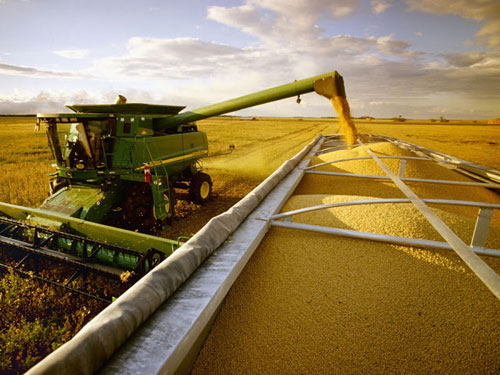The first soybean research center in Vietnam
The Vinasoy Soybean Research and Application Center (VSAC) will shorten the research gap, apply the world's advanced scientific achievements to soybean cultivation, production and processing in Vietnam.
VSAC, established by Vinasoy Company, is the first research and application of advanced soy technology in Vietnam, operating according to international standards. The center will create a bridge between scientists, apply their research results to develop soybean material and product areas, thereby improving soybean yield and quality, contributing to regional stability. Raw materials serve as a basis for Vinasoy's soybean production and processing activities.

Soybean varieties are suitable for mechanized harvesting and create favorable conditions for farmers and bring high economic efficiency.With the advent of VSAC, soybean farmer's life has also changed significantly.
VSAC will survey and assess the reality to select the experimental areas, create high-yielding soybeans, good quality to meet the needs of Vinasoy's soy products diversification. It is expected that in the next 3-5 years, the center will complete the restoration of the good characteristics of the local soybean variety, proceeding to introduce a new soybean variety suitable to Vietnam's growing conditions. In the future, Vinasoy will continue to complete synchronous solutions in raw material areas, purchasing and processing after harvest, and consuming products for farmers so that the company has stable raw materials as well as farmers. have a better income.
Based on market demand, Vinasoy through VSAC will research and develop soy products with breakthrough nutrition formula, organize seminars and seminars to update information and seek development ideas. products aimed at public health.
According to Professor Henry Nguyen, Director of NCSB, currently the productivity of soy farms in Missouri is quite high, between 3-5 tons per hectare, there are some places that can reach 11 tons for soy gene transformation . "VSAC will help Vietnamese farmers access high yielding soybean varieties, adapt well to indigenous natural conditions, drought resistance, good water-resistance, improve protein, but still retain flavor. The unique feature of Dak Nong region , ' remarked Professor Henry Nguyen.
VSAC is also expected to contribute to improving the value of soybeans in Vietnam, improving the level of mechanization and improving the lives of soybean farmers. This strategy also helps Vinasoy to be able to proactively source delicious ingredients to meet the increasingly diverse needs of consumers.
According to figures from the General Statistics Office, soybean production and area are on a downward trend in the last 3 years. In 2010, the country had 175,000 hectares of soybeans cultivated for about 300,000 tons. By 2012, production was only about 175,000 tons over 125,000 hectares. Vietnam is importing soybeans in large quantities, about 1.2 million tons a year. While this is an essential crop in rotation, it can be developed and enriched, and has a premise to develop in a country where agriculture plays a key role like Vietnam.
Mr. Ngo Van Tu, CEO of Vinasoy - an enterprise that accounts for 78% of the market share of soymilk in domestic packaging, said that with years of production experience, the company has found soy beans in the material area. Dac Nong gives typical delicious flavors. Therefore, despite many difficulties in organizing large-scale procurement, Vinasoy always prioritizes the selection of domestic raw material areas to ensure the taste and freshness of the product by reducing storage time. , transporting soy bean ingredients.
"While the demand for raw materials is increasing, the area for growing soybeans is getting smaller. Farmers quit growing soybeans because of low productivity and unsecured incomes , " Tu said.

Soybean varieties suitable for mechanized harvesting both facilitate farming for farmers, and bring high economic efficiency.
In addition to low productivity, soybean varieties currently have many other limitations such as lack of special varieties, no varieties to meet the mechanization process. Besides the intensive cultivation of farmers on a limited area, rudimentary cultivation and harvesting techniques, the process of preliminary processing and preservation is very manual so the economic efficiency and product quality are not guaranteed. . To support farmers, since 2011, Vinasoy has regularly organized field conferences to provide and exchange new farming and technical experiences, to cooperate with domestic and foreign research centers to produce new technology solutions.
In the announcement ceremony of the establishment of VSAC, Vinasoy signed a strategic cooperation memorandum with two leading US soy research partners. In the National Center for Soybean Biotechnology (NCSB), the National Center for Soybean Biotechnology Research Center (NCSB) specializes in conducting intensive research projects on varieties, and Soybean Research Center. The United States - Illinois University (National Soybean Research Laboratory - NSRL) annually has valuable soy nutrition announcements. Both centers are the focal point for connecting the activities of many senior experts in soybeans in the US and other countries.
- Successful restoration of soybean varieties in Nam Dan
- Hanoi develops a new high-yielding DT84 soybean
- Experts guide how to
- Super soybeans live without much water
- Compression JPEG IP 2000 made in Vietnam
- 12 great things that soybeans bring to your health
- Experience making summer soybean plating
- Matsushita opened a software research center in Vietnam
- NASA uses Vietnam's nano tube carbon as a spacecraft shell
- USD 500 million built a nuclear research center
- Launching Research Center for Bioenergy application
- Make cake from soybean cake to make it more nutritious
 Vietnam 5th Asian champion on fuel-efficient vehicles
Vietnam 5th Asian champion on fuel-efficient vehicles We can read all NASA studies completely free of charge
We can read all NASA studies completely free of charge Singer and songwriter Bob Dylan won the 2016 Nobel Prize for Literature
Singer and songwriter Bob Dylan won the 2016 Nobel Prize for Literature Scientific revolution in Asia
Scientific revolution in Asia